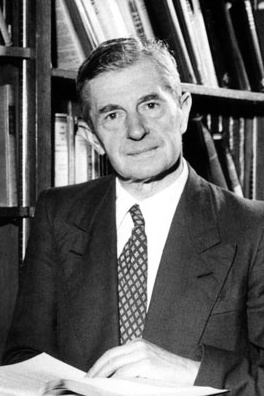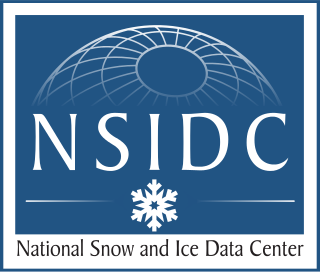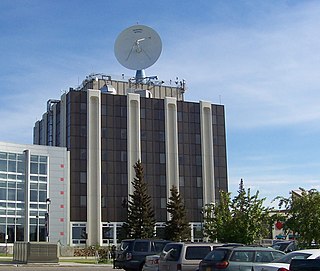
The University of Alaska System is a system of public universities in the U.S. state of Alaska. It was created in 1917 and comprises three separately accredited universities on 19 campuses. The system serves nearly 30,000 full- and part-time students and offers 400 unique degree programs.

The University of Alaska Fairbanks is a public land-grant research university in College, Alaska, a suburb of Fairbanks. It is the flagship campus of the University of Alaska system. UAF was established in 1917 and opened for classes in 1922. Originally named the Alaska Agricultural College and School of Mines, it became the University of Alaska in 1935. Fairbanks-based programs became the University of Alaska Fairbanks in 1975.

Sydney Chapman was a British mathematician and geophysicist. His work on the kinetic theory of gases, solar-terrestrial physics, and the Earth's ozone layer has inspired a broad range of research over many decades.

The National Snow and Ice Data Center (NSIDC) is a United States information and referral center in support of polar and cryospheric research. NSIDC archives and distributes digital and analog snow and ice data and also maintains information about snow cover, avalanches, glaciers, ice sheets, freshwater ice, sea ice, ground ice, permafrost, atmospheric ice, paleoglaciology, and ice cores.

The Byrd Polar and Climate Research Center (BPCRC) is a polar, alpine, and climate research center at Ohio State University founded in 1960.

The Goddard Institute for Space Studies (GISS) is a laboratory in the Earth Sciences Division of NASA's Goddard Space Flight Center affiliated with the Columbia University Earth Institute. The institute is located at Columbia University in New York City. It was named after Robert H. Goddard, American engineer, professor, physicist and inventor who is credited with creating and building the world's first liquid-fueled rocket.

The Poker Flat Research Range (PFRR) is a launch facility and rocket range for sounding rockets in the U.S. state of Alaska, located on a 5,132-acre (20.77 km2) site at Chatanika, about 30 miles (50 km) northeast of Fairbanks and 1.5 degrees south of the Arctic Circle. More than 1,700 launches have been conducted at the range to study the Earth's atmosphere and the interaction between the atmosphere and the space environment. Areas studied at PFRR include the aurora, plasma physics, the ozone layer, solar proton events, Earth's magnetic field, and ultraviolet radiation. Rockets launched at PFRR have attained an apogee of 930 miles (1,500 km).

Oceanic and Atmospheric Research (OAR) is a division of the National Oceanic and Atmospheric Administration (NOAA). OAR is also referred to as NOAA Research.

The Geophysical Institute of the University of Alaska Fairbanks conducts research into space physics and aeronomy; atmospheric sciences; snow, ice, and permafrost; seismology; volcanology; and tectonics and sedimentation. It was founded in 1946 by an act of the United States Congress.

Syun-Ichi Akasofu is the founding director of the International Arctic Research Center of the University of Alaska Fairbanks (UAF), serving in that position from the center's establishment in 1998 until January 2007. Previously he had been director of the university's Geophysical Institute from 1986.
Carmen Nicole Moelders is an American atmospheric scientist. Her work is mainly focused on hydrometeorology, mesoscale meteorology, cloud physics, land-atmosphere interaction, air pollution, wildfire modeling, and wind power modeling.
Virgil L. (Buck) Sharpton is the Associate Director for Science at the Lunar and Planetary Institute (LPI) in Houston, Texas. Prior to joining the LPI in 2011, he was Vice Chancellor for Research at the University of Alaska Fairbanks (UAF). He is also the founder and former director of the Geographic Information Network of Alaska (GINA) which provides access to university data and information services across the state.
Study of Environmental Arctic Change (SEARCH) is a collaborative program of Arctic researchers, funding agencies, and others that facilitates the synthesis of Arctic science and communicates the current understanding to help society respond to a rapidly changing Arctic.

Katey M. Walter Anthony is an Alaskan aquatic ecologist and biogeochemist researching carbon and nutrient cycling between terrestrial and aquatic systems, and the cryosphere and atmosphere.

The Institute of Arctic Biology or IAB of the University of Alaska Fairbanks, is located in Fairbanks, Alaska, US. The institute was established in 1963 by the Board of Regents of the University of Alaska, with Laurence Irving serving as its founding director. The mission of IAB is to advance basic and applied knowledge of high-latitude biological systems through research, education, and service. The Institute supports faculty, post-doctoral, and graduate research in wildlife biology and management, ecology, evolutionary biology, physiology, genetics, biomedicine, bioinformatics, and computational biology. IAB faculty hold joint appointments within other departments at UAF in the College of Natural Science and Mathematics and the School of Natural Resources and Agricultural Sciences.
The Chinese Arctic and Antarctic Administration, often abbreviated as the CAA, is a Beijing-based agency of the People's Republic of China's State Oceanic Administration (SOA). Established in 1981, it organizes China's scientific program for both the Arctic and Antarctic, and it provides logistic support to Antarctic expeditions. There are several divisions, including General Affairs, Operation & Logistics, Science Programs, International Cooperation, representation in the Chinese Embassy in Chile, and a Winter Training Base. The director is Qu Tanzhou.

The Arctic policy of the United States is the foreign policy of the United States in regard to the Arctic region. In addition, the United States' domestic policy toward Alaska is part of its Arctic policy.

The College of Fisheries and Ocean Sciences, or CFOS, is part of the University of Alaska Fairbanks. CFOS offers a bachelor of arts and a bachelor of science in fisheries, master’s and doctoral degrees in oceanography, fisheries and marine biology, and a minor in marine science.
The Qijurittuq archaeological site (IbGk-3) is an archaeological site located on Drayton Island on the eastern shore of Hudson Bay, Nunavik, in Quebec, Canada. The site contains structural remains and artifacts relating to the Thule/Inuit culture dating back to approximately 700 to 800 years ago.
Adelheid Herrmann is a Dena'ina Athabaskan researcher and politician. She is a shareholder in the Bristol Bay Native Corporation, one of the 13 Alaska Native corporations.















